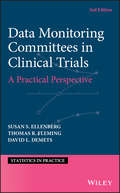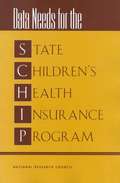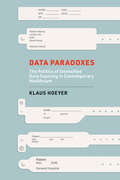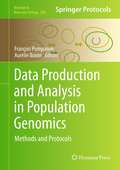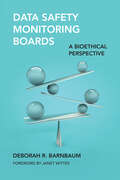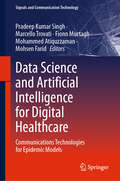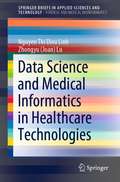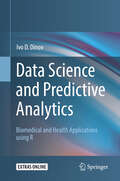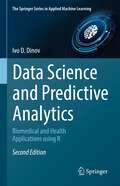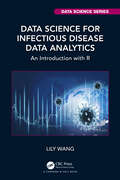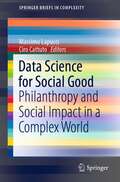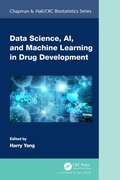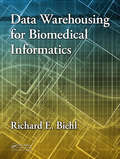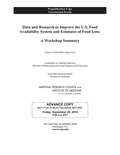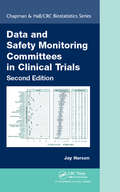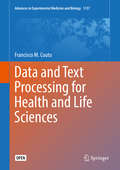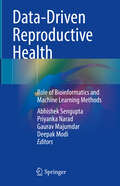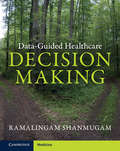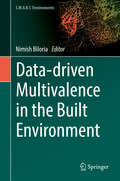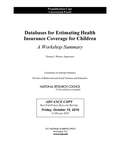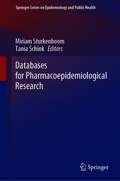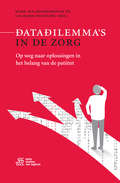- Table View
- List View
Data Monitoring Committees in Clinical Trials: A Practical Perspective (Statistics in Practice #6)
by Thomas R. Fleming David L. DeMets Susan S. EllenbergThe authoritative guide for Data Monitoring Committees—fully revised and updated The number of clinical trials sponsored by government agencies and pharmaceutical companies has grown in recent years, prompting an increased need for interim monitoring of data on safety and efficacy. Data Monitoring Committees (DMCs) are an essential component of many clinical trials, safeguarding trial participants and protecting the credibility and validity of the study. Data Monitoring Committees in Clinical Trials: A Practical Perspective, 2nd Edition offers practical advice for those managing and conducting clinical trials and serving on Data Monitoring Committees, providing a practical overview of the establishment, purpose, and responsibilities of these committees. Examination of topics such as the composition and independence of DMCs, statistical, philosophical and ethical considerations, and determining when a DMC is needed, presents readers with a comprehensive foundational knowledge of clinical trial oversight. Providing recent examples to illustrate DMC principles, this fully-updated guide reflects current developments and practices in clinical trial oversight and offers expanded coverage of emerging issues and challenges in the field. This new second edition covers the most current information on DMC policies, issues in monitoring trials using new designs, and recent trial publications relevant to DMC decision-making. • Presents practical advice for those managing and conducting clinical trials and serving on Data Monitoring Committees • Illustrates the types of challenging issues Data Monitoring Committees face in practical situations • Provides updated and expanded coverage of topics including regulatory and funding agency guidelines and trial designs and their associated demands and limitations • Includes a new chapter addressing legal issues that affect DMC members and discusses general litigation concerns relevant to clinical research • Expands treatment of current journal publications addressing DMC issues Data Monitoring Committees in Clinical Trials: A Practical Perspective, 2nd Edition is a must-have text for anyone engaged in DMC activities as well as trial sponsors, clinical trial researchers, regulatory and bioethics professionals, and those associated with clinical trials in academic, government and industry settings.
Data Needs for the STATE CHILDREN'S HEALTH INSURANCE PROGRAM
by Panel for the Workshop on the State Children's Health Insurance ProgramThe National Academies Press (NAP)--publisher for the National Academies--publishes more than 200 books a year offering the most authoritative views, definitive information, and groundbreaking recommendations on a wide range of topics in science, engineering, and health. Our books are unique in that they are authored by the nation's leading experts in every scientific field.
Data Paradoxes: The Politics of Intensified Data Sourcing in Contemporary Healthcare
by Klaus HoeyerWhy healthcare cannot—and should not—become data-driven, despite the many promises of intensified data sourcing.In contemporary healthcare, everybody seems to want more data, of higher quality, on more people, and to use this data for a wider range of purposes. In theory, such pervasive data collection should lead to a healthcare system in which data can quickly, efficiently, and unambiguously be interpreted and provide better care for patients, more efficient administration, enhanced options for research, and accelerated economic growth. In practice, however, data are difficult to interpret and the many purposes often undermine one another. In this book, anthropologist and STS scholar Klaus Hoeyer offers an in-depth look at the paradoxes surrounding healthcare data.Focusing on Denmark, a world leader in healthcare data infrastructures, Hoeyer shares the perspectives of different stakeholders, from epidemiologists to hospital managers, from patients to physicians, analyzing the social dynamics set in motion by data intensification and calling special attention to that which cannot be easily coded in a database. HHe illustrates how data can be at once helpful, overwhelming, and sometimes disastrous through concrete examples. The COVID-19 pandemic serves as a special closing case study that shows how these data paradoxes carry weighty political implications. By revealing the diverse and sometimes contradictory practices spawned by intensified data sourcing, Data Paradoxes raises vital questions about how we might better use healthcare data.
Data Privacy During Pandemics: A Scorecard Approach for Evaluating the Privacy Implications of COVID-19 Mobile Phone Surveillance Programs
by Ricardo Sanchez Benjamin Boudreaux Matthew A. DeNardo Sarah W. Denton Katie Feistel Hardika DayalaniAs part of the response to the COVID-19 pandemic, governments worldwide have deployed mobile phone surveillance programs to augment public health interventions. However, these programs raise privacy concerns. The authors of this report examine whether two goals can be achieved concurrently: the use of mobile phones as public health surveillance tools to help manage COVID‑19 and future crises, and the protection of privacy and civil liberties.
Data Production and Analysis in Population Genomics: Methods and Protocols (Methods in Molecular Biology #888)
by Aurélie Bonin François PompanonPopulation genomics is a recently emerged discipline, which aims at understanding how evolutionary processes influence genetic variation across genomes. Today, in the era of cheaper next-generation sequencing, it is no longer as daunting to obtain whole genome data for any species of interest and population genomics is now conceivable in a wide range of fields, from medicine and pharmacology to ecology and evolutionary biology. However, because of the lack of reference genome and of enough a priori data on the polymorphism, population genomics analyses of populations will still involve higher constraints for researchers working on non-model organisms, as regards the choice of the genotyping/sequencing technique or that of the analysis methods. Therefore, Data Production and Analysis in Population Genomics purposely puts emphasis on protocols and methods that are applicable to species where genomic resources are still scarce. It is divided into three convenient sections, each one tackling one of the main challenges facing scientists setting up a population genomics study. The first section helps devising a sampling and/or experimental design suitable to address the biological question of interest. The second section addresses how to implement the best genotyping or sequencing method to obtain the required data given the time and cost constraints as well as the other genetic resources already available, Finally, the last section is about making the most of the (generally huge) dataset produced by using appropriate analysis methods in order to reach a biologically relevant conclusion. Written in the successful Methods in Molecular BiologyTM series format, chapters include introductions to their respective topics, lists of the necessary materials and reagents, step-by-step, readily reproducible protocols, advice on methodology and implementation, and notes on troubleshooting and avoiding known pitfalls. Authoritative and easily accessible, Data Production and Analysis in Population Genomics serves a wide readership by providing guidelines to help choose and implement the best experimental or analytical strategy for a given purpose.
Data Safety Monitoring Boards: A Bioethical Perspective (Basic Bioethics)
by Deborah R. BarnbaumA critical and underexplored area of bioethics—ethical issues that emerge from the data monitoring of clinical trials.Data Safety Monitoring Boards explores ethical issues confronted by data safety monitoring boards, or DSMBs, overseeing large randomized clinical trials. DSMBs meet on a regular basis to ensure that the expected benefits of a study continue to outweigh its risks and that side effects are monitored. They are empowered to recommend to study sponsors that studies be halted if ethical protections fail.Written by bioethicist Deborah Barnbaum, who has served as a clinical ethicist and patient advocate on several DSMBs for the National Institutes of Health since 2006, this book combines compelling narratives about clinical trials, the ethical quandaries that emerge when overseeing those studies, and the theoretical considerations that guide the practices of DSMBs.
Data Science and Artificial Intelligence for Digital Healthcare: Communications Technologies for Epidemic Models (Signals and Communication Technology)
by Fionn Murtagh Marcello Trovati Mohammed Atiquzzaman Pradeep Kumar Singh Mohsen FaridThis book explores current research and development in the area of digital healthcare using recent technologies such as data science and artificial intelligence. The authors discuss how data science, AI, and mobile technologies provide the fundamental backbone to digital healthcare, presenting each technology separately as well covering integrated solutions. The book also focuses on the integration of different multi-disciplinary approaches along with examples and case studies. In order to identify the challenges with security and privacy issues, relevant block chain technologies are identified and discussed. Social aspects related to digital solutions and platforms for healthcare are also discussed and analyzed. The book aims to present high quality, technical contributions in the field of mobile digital healthcare using technologies such as AI, deep learning, IoT and distributed cloud computing.
Data Science and Medical Informatics in Healthcare Technologies (SpringerBriefs in Applied Sciences and Technology)
by Nguyen Thi Dieu Linh Zhongyu (Joan) LuThis book highlights a timely and accurate insight at the endeavour of the bioinformatics and genomics clinicians from industry and academia to address the societal needs. The contents of the book unearth the lacuna between the medication and treatment in the current preventive medicinal and pharmaceutical system. It contains chapters prepared by experts in life sciences along with data scientists for examining the circumstances of health care system for the next decade. It also highlights the automated processes for analyzing data in clinical trial research, specifically for drug development. Additionally, the data science solutions provided in this book help pharmaceutical companies to improve on what had historically been manual, costly and laborious process for cross-referencing research in clinical trials on drug development, while laying the groundwork for use with a full range of other drugs for the conditions ranging from tuberculosis, to diabetes, to heart attacks and many others.
Data Science and Predictive Analytics: Biomedical And Health Applications Using R
by Ivo D. DinovOver the past decade, Big Data have become ubiquitous in all economic sectors, scientific disciplines, and human activities. They have led to striking technological advances, affecting all human experiences. Our ability to manage, understand, interrogate, and interpret such extremely large, multisource, heterogeneous, incomplete, multiscale, and incongruent data has not kept pace with the rapid increase of the volume, complexity and proliferation of the deluge of digital information. There are three reasons for this shortfall. First, the volume of data is increasing much faster than the corresponding rise of our computational processing power (Kryder’s law > Moore’s law). Second, traditional discipline-bounds inhibit expeditious progress. Third, our education and training activities have fallen behind the accelerated trend of scientific, information, and communication advances. There are very few rigorous instructional resources, interactive learning materials, and dynamic training environments that support active data science learning. The textbook balances the mathematical foundations with dexterous demonstrations and examples of data, tools, modules and workflows that serve as pillars for the urgently needed bridge to close that supply and demand predictive analytic skills gap. Exposing the enormous opportunities presented by the tsunami of Big data, this textbook aims to identify specific knowledge gaps, educational barriers, and workforce readiness deficiencies. Specifically, it focuses on the development of a transdisciplinary curriculum integrating modern computational methods, advanced data science techniques, innovative biomedical applications, and impactful health analytics. The content of this graduate-level textbook fills a substantial gap in integrating modern engineering concepts, computational algorithms, mathematical optimization, statistical computing and biomedical inference. Big data analytic techniques and predictive scientific methods demand broad transdisciplinary knowledge, appeal to an extremely wide spectrum of readers/learners, and provide incredible opportunities for engagement throughout the academy, industry, regulatory and funding agencies. The two examples below demonstrate the powerful need for scientific knowledge, computational abilities, interdisciplinary expertise, and modern technologies necessary to achieve desired outcomes (improving human health and optimizing future return on investment). This can only be achieved by appropriately trained teams of researchers who can develop robust decision support systems using modern techniques and effective end-to-end protocols, like the ones described in this textbook. • A geriatric neurologist is examining a patient complaining of gait imbalance and posture instability. To determine if the patient may suffer from Parkinson’s disease, the physician acquires clinical, cognitive, phenotypic, imaging, and genetics data (Big Data). Most clinics and healthcare centers are not equipped with skilled data analytic teams that can wrangle, harmonize and interpret such complex datasets. A learner that completes a course of study using this textbook will have the competency and ability to manage the data, generate a protocol for deriving biomarkers, and provide an actionable decision support system. The results of this protocol will help the physician understand the entire patient dataset and assist in making a holistic evidence-based, data-driven, clinical diagnosis.• To improve the return on investment for their shareholders, a healthcare manufacturer needs to forecast the demand for their product subject to environmental, demographic, economic, and bio-social sentiment data (Big Data). The organization’s data-analytics team is tasked with developing a protocol that identifies, aggregates, harmonizes, models and analyzes these heterogeneous data elements to generate a trend forecast. This system needs to provide an automated, adaptive, scalable, and reliable prediction of the optimal investment, e.g., R&D allocation, that maximizes the company’s bot
Data Science and Predictive Analytics: Biomedical and Health Applications using R (The Springer Series in Applied Machine Learning)
by Ivo D. DinovThis textbook integrates important mathematical foundations, efficient computational algorithms, applied statistical inference techniques, and cutting-edge machine learning approaches to address a wide range of crucial biomedical informatics, health analytics applications, and decision science challenges. Each concept in the book includes a rigorous symbolic formulation coupled with computational algorithms and complete end-to-end pipeline protocols implemented as functional R electronic markdown notebooks. These workflows support active learning and demonstrate comprehensive data manipulations, interactive visualizations, and sophisticated analytics. The content includes open problems, state-of-the-art scientific knowledge, ethical integration of heterogeneous scientific tools, and procedures for systematic validation and dissemination of reproducible research findings.Complementary to the enormous challenges related to handling, interrogating, and understanding massive amounts of complex structured and unstructured data, there are unique opportunities that come with access to a wealth of feature-rich, high-dimensional, and time-varying information. The topics covered in Data Science and Predictive Analytics address specific knowledge gaps, resolve educational barriers, and mitigate workforce information-readiness and data science deficiencies. Specifically, it provides a transdisciplinary curriculum integrating core mathematical principles, modern computational methods, advanced data science techniques, model-based machine learning, model-free artificial intelligence, and innovative biomedical applications. The book’s fourteen chapters start with an introduction and progressively build foundational skills from visualization to linear modeling, dimensionality reduction, supervised classification, black-box machine learning techniques, qualitative learning methods, unsupervised clustering, model performance assessment, feature selection strategies, longitudinal data analytics, optimization, neural networks, and deep learning. The second edition of the book includes additional learning-based strategies utilizing generative adversarial networks, transfer learning, and synthetic data generation, as well as eight complementary electronic appendices. This textbook is suitable for formal didactic instructor-guided course education, as well as for individual or team-supported self-learning. The material is presented at the upper-division and graduate-level college courses and covers applied and interdisciplinary mathematics, contemporary learning-based data science techniques, computational algorithm development, optimization theory, statistical computing, and biomedical sciences. The analytical techniques and predictive scientific methods described in the book may be useful to a wide range of readers, formal and informal learners, college instructors, researchers, and engineers throughout the academy, industry, government, regulatory, funding, and policy agencies. The supporting book website provides many examples, datasets, functional scripts, complete electronic notebooks, extensive appendices, and additional materials.
Data Science for Infectious Disease Data Analytics: An Introduction with R (Chapman & Hall/CRC Data Science Series)
by Lily WangData Science for Infectious Disease Data Analytics: An Introduction with R provides an overview of modern data science tools and methods that have been developed specifically to analyze infectious disease data. With a quick start guide to epidemiological data visualization and analysis in R, this book spans the gulf between academia and practices providing many lively, instructive data analysis examples using the most up-to-date data, such as the newly discovered coronavirus disease (COVID-19). The primary emphasis of this book is the data science procedures in epidemiological studies, including data wrangling, visualization, interpretation, predictive modeling, and inference, which is of immense importance due to increasingly diverse and nonexperimental data across a wide range of fields. The knowledge and skills readers gain from this book are also transferable to other areas, such as public health, business analytics, environmental studies, or spatio-temporal data visualization and analysis in general. Aimed at readers with an undergraduate knowledge of mathematics and statistics, this book is an ideal introduction to the development and implementation of data science in epidemiology. Features Describes the entire data science procedure of how the infectious disease data are collected, curated, visualized, and fed to predictive models, which facilitates effective communication between data sources, scientists, and decision-makers. Explains practical concepts of infectious disease data and provides particular data science perspectives. Overview of the unique features and issues of infectious disease data and how they impact epidemic modeling and projection. Introduces various classes of models and state-of-the-art learning methods to analyze infectious diseases data with valuable insights on how different models and methods could be connected.
Data Science for Social Good: Philanthropy and Social Impact in a Complex World (SpringerBriefs in Complexity)
by Massimo Lapucci Ciro CattutoThis book is a collection of reflections by thought leaders at first-mover organizations in the exploding field of "Data Science for Social Good", meant as the application of knowledge from computer science, complex systems and computational social science to challenges such as humanitarian response, public health, sustainable development. The book provides both an overview of scientific approaches to social impact – identifying a social need, targeting an intervention, measuring impact – and the complementary perspective of funders and philanthropies that are pushing forward this new sector. This book will appeal to students and researchers in the rapidly growing field of data science for social impact, to data scientists at companies whose data could be used to generate more public value, and to decision makers at nonprofits, foundations, and agencies that are designing their own agenda around data.
Data Science, AI, and Machine Learning in Drug Development (Chapman & Hall/CRC Biostatistics Series)
by Harry YangThe confluence of big data, artificial intelligence (AI), and machine learning (ML) has led to a paradigm shift in how innovative medicines are developed and healthcare delivered. To fully capitalize on these technological advances, it is essential to systematically harness data from diverse sources and leverage digital technologies and advanced analytics to enable data-driven decisions. Data science stands at a unique moment of opportunity to lead such a transformative change. Intended to be a single source of information, Data Science, AI, and Machine Learning in Drug Research and Development covers a wide range of topics on the changing landscape of drug R & D, emerging applications of big data, AI and ML in drug development, and the build of robust data science organizations to drive biopharmaceutical digital transformations. Features Provides a comprehensive review of challenges and opportunities as related to the applications of big data, AI, and ML in the entire spectrum of drug R & D Discusses regulatory developments in leveraging big data and advanced analytics in drug review and approval Offers a balanced approach to data science organization build Presents real-world examples of AI-powered solutions to a host of issues in the lifecycle of drug development Affords sufficient context for each problem and provides a detailed description of solutions suitable for practitioners with limited data science expertise
Data Warehousing for Biomedical Informatics
by Richard E. BiehlData Warehousing for Biomedical Informatics is a step-by-step how-to guide for designing and building an enterprise-wide data warehouse across a biomedical or healthcare institution, using a four-iteration lifecycle and standardized design pattern. It enables you to quickly implement a fully-scalable generic data architecture that supports your organization's clinical, operational, administrative, financial, and research data. By following the guidelines in this book, you will be able to successfully progress through the Alpha, Beta, and Gamma versions, plus fully implement your first production release in about a year.
Data and Research to Improve the U.S. Food Availability System and Estimates of Food Loss: A Workshop Report
by Nancy J. KirkendallThe United States Department of Agriculture's (USDA's) Economic Research Service's (ERS) Food Availability Data System includes three distinct but related data series on food and nutrient availability for consumption. The data serve as popular proxies for actual consumption at the national level for over 200 commodities (e. g. , fresh spinach, beef, and eggs). The core Food Availability (FA) data series provides data on the amount of food available, per capita, for human consumption in the United States with data back to 1909 for many commodities. The Loss-Adjusted Food Availability (LAFA) data series is derived from the FA data series by adjusting for food spoilage, plate waste, and other losses to more closely approximate 4 actual intake. The LAFA data provide daily estimates of the per capita availability amounts adjusted for loss (e. g. , in pounds, ounces, grams, and gallons as appropriate), calories, and food pattern equivalents (i. e. , "servings") of the five major food groups (fruit, vegetables, grains, meat, and dairy) available for consumption plus the amounts of added sugars and sweeteners and added fats and oils available for consumption. This fiscal year, as part of its initiative to systematically review all of its major data series, ERS decided to review the FADS data system. One of the goals of this review is to advance the knowledge and understanding of the measurement and technical aspects of the data supporting FADS so the data can be maintained and improved. "Data and Research to Improve the U. S. Food Availability System and Estimates of Food Loss" is the summary of a workshop convened by the Committee on National Statistics of the National Research Council and the Food and Nutrition Board of the Institute of Medicine to advance knowledge and understanding of the measurement and technical aspects of the data supporting the LAFA data series so that these data series and subsequent food availability and food loss estimates can be maintained and improved. The workshop considered such issues as the effects of termination of selected Census Bureau and USDA data series on estimates for affected food groups and commodities; the potential for using other data sources, such as scanner data, to improve estimates of food availability; and possible ways to improve the data on food loss at the farm and retail levels and at restaurants. This report considers knowledge gaps, data sources that may be available or could be generated to fill gaps, what can be learned from other countries and international organizations, ways to ensure consistency of treatment of commodities across series, and the most promising opportunities for new data for the various food availability series.
Data and Safety Monitoring Committees in Clinical Trials (Chapman & Hall/CRC Biostatistics Series)
by Jay HersonPraise for the first edition: "Given the author’s years of experience as a statistician and as a founder of the first DMC in pharmaceutical industry trials, I highly recommend this book—not only for experts because of its cogent and organized presentation, but more importantly for young investigators who are seeking information about the logistical and philosophical aspects of a DMC." -S. T. Ounpraseuth, The American Statistician In the first edition of this well-regarded book, the author provided a groundbreaking and definitive guide to best practices in pharmaceutical industry data monitoring committees (DMCs). Maintaining all the material from the first edition and adding substantial new material, Data and Safety Monitoring Committees in Clinical Trials, Second Edition is ideal for training professionals to serve on their first DMC as well as for experienced clinical and biostatistical DMC members, sponsor and regulatory agency staff. The second edition guides the reader through newly emerging DMC responsibilities brought about by regulations emphasizing risk vs benefit and the emergence of risk-based monitoring. It also provides the reader with many new statistical methods, clinical trial designs and clinical terminology that have emerged since the first edition. The references have been updated and the very popular end-of-chapter Q&A section has been supplemented with many new experiences since the first edition. New to the Second Edition: Presents statistical methods, tables, listings and graphs appropriate for safety review, efficacy analysis and risk vs benefit analysis, SPERT and PRISMA initiatives. Newly added interim analysis for efficacy and futility section. DMC responsibilities in SUSARs (Serious Unexpected Serious Adverse Reactions), basket trials, umbrella trials, dynamic treatment strategies /SMART trials, pragmatic trials, biosimilar trials, companion diagnostics, etc. DMC responsibilities for data quality and fraud detection (Fraud Recovery Plan) Use of patient reported outcomes of safety Use of meta analysis and data outside the trial New ideas for training and compensation of DMC members Jay Herson is Senior Associate, Biostatistics, Johns Hopkins Bloomberg School of Public Health where he teaches courses on clinical trials and drug development based on his many years experience in clinical trials in academia and the pharmaceutical industry.
Data and Text Processing for Health and Life Sciences (Advances in Experimental Medicine and Biology #1137)
by Francisco M. CoutoThis open access book is a step-by-step introduction on how shell scripting can help solve many of the data processing tasks that Health and Life specialists face everyday with minimal software dependencies. The examples presented in the book show how simple command line tools can be used and combined to retrieve data and text from web resources, to filter and mine literature, and to explore the semantics encoded in biomedical ontologies. To store data this book relies on open standard text file formats, such as TSV, CSV, XML, and OWL, that can be open by any text editor or spreadsheet application. The first two chapters, Introduction and Resources, provide a brief introduction to the shell scripting and describe popular data resources in Health and Life Sciences. The third chapter, Data Retrieval, starts by introducing a common data processing task that involves multiple data resources. Then, this chapter explains how to automate each step of that task by introducing the required commands line tools one by one. The fourth chapter, Text Processing, shows how to filter and analyze text by using simple string matching techniques and regular expressions. The last chapter, Semantic Processing, shows how XPath queries and shell scripting is able to process complex data, such as the graphs used to specify ontologies. Besides being almost immutable for more than four decades and being available in most of our personal computers, shell scripting is relatively easy to learn by Health and Life specialists as a sequence of independent commands. Comprehending them is like conducting a new laboratory protocol by testing and understanding its procedural steps and variables, and combining their intermediate results. Thus, this book is particularly relevant to Health and Life specialists or students that want to easily learn how to process data and text, and which in return may facilitate and inspire them to acquire deeper bioinformatics skills in the future.
Data-Driven Decision Support System in Intelligent HealthCare
by Yu-Chen Hu Debnath BhattacharyyaMachine Intelligence with Generative AI is one of the most trending topics with applications in almost all fields of life. In healthcare, it is not only accelerating the development of new products, but also automating the generation of new and synthetic content making it easier to train and improve machine learning models.Some of the biggest achievements of Generative AI in healthcare have been drug discovery, personalized care, differentially private synthetic data generation, operational efficiency, and many more. Generative AI models like Generative Adversarial Networks, and Variational Autoencoders are employed to generate synthetic medical images, aiding in data augmentation, facilitating disease diagnosis, and enabling advanced medical imaging research. Additionally, Generative AI techniques are being utilized for creating realistic electronic health records (EHRs) and simulated patient data, supporting privacy-preserving data sharing, and empowering innovative studies for personalized medicine and drug development. NLP models like ClinicalBERT use transformer-based deep learning architecture to understand and represent contextual information in large clinical text datasets, such as electronic health records (EHRs) and medical literature, and can better grasp medical terminologies, domain-specific language, and contextual nuances that are unique to the healthcare field.This volume delves into the realm of Machine Intelligence with Generative AI and explores its impact on the healthcare industry.
Data-Driven Reproductive Health: Role of Bioinformatics and Machine Learning Methods
by Gaurav Majumdar Abhishek Sengupta Priyanka Narad Deepak ModiThis book provides insight into the transformative impact of data-driven approaches on reproductive health. Chapters cover a wealth of intricate algorithms of genomic analysis, predictive modeling, and personalized treatment strategies, providing an up-to-date view of the reproductive healthcare landscape. With more than 20 code-based examples, the book decodes complex biological data using bioinformatics and machine learning and provides valuable insights into fertility, genetic disorders, and personalized medicine. This book is relevant for healthcare professionals, researchers, and students in the fields of reproductive medicine, bioinformatics, and genetics.
Data-Guided Healthcare Decision Making
by Ramalingam ShanmugamHow does data evidence matter in decision-making in healthcare? How do you implement and maintain cost effective healthcare operations? Do decision trees help to sharpen decision making? This book will answer these questions, demystifying the many questions by clearly showing how to analyse data and how to interpret the results – vital skills for anyone who will go on to work in health administration in hospitals, clinics, pharmaceutical or insurance industries. Written by an expert in health and medical informatics, this book introduces readers to the fundamentals of operational decision making by illustrating the ideas and tools to reach optimal healthcare, drawing on numerous healthcare data sets from multiple sources. Aimed at an audience of graduate students and lecturers in Healthcare Administration and Business Administration courses and heavily illustrated throughout, this book includes up-to-date concepts, new methodologies and interpretations using widely available software: Excel, Microsoft Mathematics, MathSolver and JASP.
Data-driven Multivalence in the Built Environment (S.M.A.R.T. Environments)
by Nimish BiloriaThis book sets the stage for understanding how the exponential escalation of digital ubiquity in the contemporary environment is being absorbed, modulated, processed and actively used for enhancing the performance of our built environment. S.M.A.R.T., in this context, is thus used as an acronym for Systems & Materials in Architectural Research and Technology, with a specific focus on interrogating the intricate relationship between information systems and associative material, cultural and socioeconomic formations within the built environment. This interrogation is deeply rooted in exploring inter-disciplinary research and design strategies involving nonlinear processes for developing meta-design systems, evidence based design solutions and methodological frameworks, some of which, are presented in this issue. Urban health and wellbeing, urban mobility and infrastructure, smart manufacturing, Interaction Design, Urban Design & Planning as well as Data Science, as prominent symbiotic domains constituting the Built Environment are represented in this first book in the S.M.A.R.T. series. The spectrum of chapters included in this volume helps in understanding the multivalence of data from a socio-technical perspective and provides insight into the methodological nuances involved in capturing, analysing and improving urban life via data driven technologies.
Databases for Estimating Health Insurance Coverage for Children: A Workshop Summary
by National Research Council of the National AcademiesThis report summarizes the proceedings of a workshop convened in June 2010 to critically examine the various databases that could provide national and state-level estimates of low-income uninsured children and could be effectively used as criteria for monitoring children's health insurance coverage.
Databases for Pharmacoepidemiological Research (Springer Series on Epidemiology and Public Health)
by Miriam Sturkenboom Tania SchinkThis book allows readers to gain an in-depth understanding of the role of real-world data in pharmacoepidemiology, and highlights the strengths and limitations of the respective databases with regard to pharmacoepidemiological research. Over the past decade, the increasing use of real-world data in pharmacoepidemiological research has been accompanied by a growing recognition of the value of real-world evidence in clinical and regulatory decision-making. Electronic healthcare databases allow analyses of drug and vaccine utilization in routine care after approval, as well as investigations of their comparative effectiveness and safety. They are especially useful for the identification of rare risks and rare drug exposures over long periods of time, and as such sustainably extend the basis for drug safety research. This book provides an introduction to the role of real-world data in pharmacoepidemiological research and the main developments in the last 15 years. It also offers a comprehensive overview of the general classification characteristics of databases, together with their strengths and limitations, and a detailed description of 21 individual databases, written by professionals who work with or maintain them.
Datadilemma's in de zorg: Op weg naar oplossingen in het belang van de patiënt
by Mark Van Houdenhoven Jan Harm ZwavelingDigitale data vormen een onuitputtelijke energiebron. Data kunnen de zorg slimmer, zuiniger en persoonlijker maken. Dat weten onderzoekers, dokters en patiënten. Tegelijkertijd stuiten zij op grenzen en valkuilen. Technische verleidingen, juridische obstakels en ethische dilemma’s. Van wie zijn al die data die de zorg verzamelt? Wie gebruikt ze waarvoor? Gaan techbedrijven er integer mee om? Wie is verantwoordelijk voor verkeerde beslissingen, gebaseerd op data? En kan iemand patiënten verplichten om hun data te doneren? Uiteindelijk is leiderschap vereist. In dit boekje nodigen de bestuurders van Máxima MC en de Sint Maartenskliniek talrijke auteurs uit om mee te denken. Zij willen een nationale dialoog veroorzaken. Het doel: het formuleren van breed gedragen afspraken om de datadilemma’s in de zorg op te lossen.
Datenanalyse für Naturwissenschaftler, Mediziner und Ingenieure
by Mario SchneiderDieses Buch bietet Ihnen eine verständlich vermittelte Ausgangsbasis für die praktische Anwendung datenanalytischer Methoden, die sinnvolle Interpretation von Daten und die Ableitung von Informationen. Dabei setzt dieses Buch anstelle langer mathematischer Herleitungen und Beweise auf konkrete Beispiele, die jeweils Schritt für Schritt nachvollzogen werden. Die ausgewählten Beispieldaten werden mit Hilfe von Excel analysiert und das Erlernte kann anhand von Übungsaufgaben überprüft werden. Zusätzlich können Sie in Onlinevideos die Rechenschritte nachvollziehen und parallel in Excel mitrechnen. Damit liefert Ihnen dieses Buch nicht nur das für die wissenschaftliche Praxis notwendige Basiswissen der Datenanalyse, sondern bietet gleichermaßen das Fundament für einen souveränen Umgang mit den entsprechenden Instrumenten. Dieses Buch unterstützt somit Naturwissenschaftler, Mediziner und Ingenieure in Studium und Praxis und bietet einen leichten Einstieg in die statistische Datenanalyse und ihre Anwendung in Excel.
